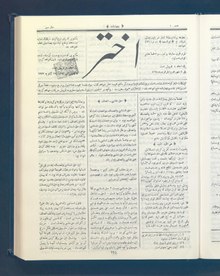
The Princes' Islands, officially just Adalar ; alternatively the Princes' Archipelago; is an archipelago off the coast of Istanbul, Turkey, in the Sea of Marmara. The islands constitute the municipality and district of Adalar within Istanbul Province. With a total land area of 11 km2 (4.2 sq mi), it is the fifth smallest district in Istanbul, and with a permanent population of 16,690 (2022), it is by far the least populous district in Istanbul.

Burgazada, or Burgaz Adası, is the third largest of the Princes' Islands in the Sea of Marmara, near Istanbul, Turkey. It is officially a neighbourhood in the municipality and district of Adalar, Istanbul Province, Turkey. Its population is 1,655 (2022). In the past, it was called Antigoni after Antigonus I Monophthalmus, the father of Demetrius I of Macedon, one of the Diadochi (Successors) of Alexander the Great, who built a fort here. The name Burgas is thought to be derived from Pyrgos.
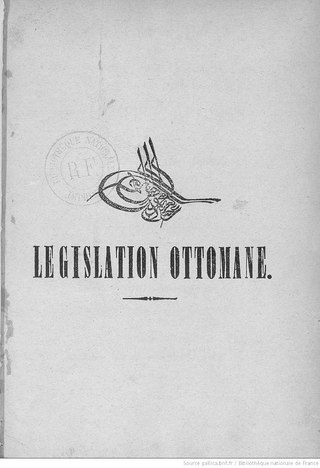
The Imperial Reform Edict was a February 18, 1856 edict of the Ottoman government and part of the Tanzimat reforms. The decree from Ottoman Sultan Abdulmejid I promised equality in education, government appointments, and administration of justice to all regardless of creed. The decree is often seen as a result of the influence of France and Britain, which assisted the Ottoman Empire against the Russians during the Crimean War (1853–1856) and the Treaty of Paris (1856) which ended the war.

Halide Edib Adıvar was a Turkish novelist, teacher, and a nationalist and feminist intellectual. She was best known for her novels criticizing the low social status of Turkish women and what she saw from her observation as the lack of interest of most women in changing their situation. She was a Pan-Turkist and several of her novels advocated for the Turanism movement.
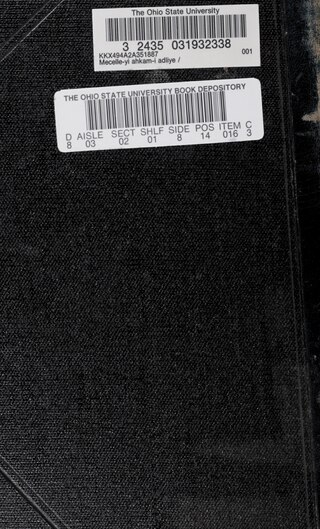
The Mecelle-i Ahkâm-ı Adliye, or the Mecelle in short, was the civil code of the Ottoman Empire in the late 19th and early 20th century. It is the first codification of Sharia law by an Islamic nation.

The Constitution of the Ottoman Empire was the first and only constitution of the Ottoman Empire. Written by members of the Young Ottomans, particularly Midhat Pasha, during the reign of Sultan Abdul Hamid II, the constitution was in effect from 1876 to 1878 in a period known as the First Constitutional Era, and from 1908 to 1922 in the Second Constitutional Era. After Abdul Hamid's political downfall in the 31 March Incident, the Constitution was amended to transfer more power from the sultan and the appointed Senate to the popularly-elected lower house: the Chamber of Deputies.
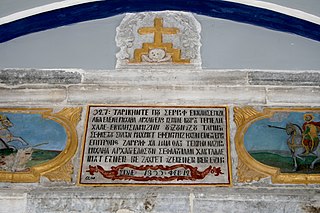
Karamanli Turkish is an extinct dialect of the Turkish language spoken by the Karamanlides. Although the official Ottoman Turkish was written in the Arabic script, the Karamanlides used the Greek alphabet to write their form of Turkish. Karamanlı Turkish had its own literary tradition and produced numerous published works in print during the 19th century, some of them published by the British and Foreign Bible Society as well as by Evangelinos Misailidis in the Anatoli or Misailidis publishing house.

Servet-i Fünun was an avant-garde journal published in the Ottoman Empire and later in Turkey. Halit Ziya (Uşaklıgil) and the other writers of the "New Literature" movement published it to inform their readers about European, particularly French, cultural and intellectual movements. In operation from 1891 until 1944, it was for its first year a supplement of the newspaper Servet, but became an independent publication from 1892.
The history of Middle Eastern newspaper publishing goes back to the 19th century. The Nahda was an important period for the development of newspaper publishing in the Middle East. During this period, a shift from government and missionary publishing to private publishing occurred. Especially in Egypt and Lebanon, newspapers became intertwined with daily life. Consequently, the rise of newspaper publishing impacted nationalism in Arab countries.
Gregory "Ligor" Aristarchis, also known as Aristarchi Bey, was an Ottoman diplomat of Phanariote Greek ethnicity, compiler of a corpus of Ottoman legislation.

The language of the court and government of the Ottoman Empire was Ottoman Turkish, but many other languages were in contemporary use in parts of the empire. The Ottomans had three influential languages, known as "Alsina-i Thalātha", that were common to Ottoman readers: Ottoman Turkish, Arabic and Persian. Turkish was spoken by the majority of the people in Anatolia and by the majority of Muslims of the Balkans except in Albania, Bosnia, and various Aegean Sea islands; Persian was initially a literary and high-court language used by the educated in the Ottoman Empire before being displaced by Ottoman Turkish; and Arabic, which was the legal and religious language of the empire, was also spoken regionally, mainly in Arabia, North Africa, Mesopotamia and the Levant.

Takvim-i Vekayi was the first fully Turkish language newspaper. It was launched in 1831 by Sultan Mahmud II, taking over from the Moniteur ottoman as the Official Gazette of the Ottoman Empire. With the beginning of the Tanzimat reform period, Takvim-i Vekayi produced versions in multiple language editions. It ceased publication in 1878, resuming in 1891–2, before being closed again. It resumed in 1908 until around 1922. In the 1831-1878 period it published a total of 2119 issues - an average of slightly less than one a week.
Le Stamboul was a French language newspaper published from Constantinople, the entirety of which is now known as Istanbul, in the Ottoman Empire and then in Turkey from 1875 to 1962. It was the leading French newspaper in the city. As of the beginning of the 20th century it was estimated to have a daily circulation of around 5,000. The founders of the paper were Irish brothers, John Laffan Hanly and Baron Henry Laffan Hanly. The latter was the director and the former was the founding editor. Pierre Le Goff was one of the editors-in-chief of the paper which was published six days per week.
The Moniteur ottoman was a newspaper written in French and first published in 1831 on the order of Mahmud II. It was the first official gazette of the Ottoman Empire, edited by Alexandre Blacque at the expense of the Sublime Porte. Its name perhaps referred to the French newspaper Le Moniteur Universel. It was issued weekly. Mahmud II wished to influence Europeans. Takvim-i vekayi was published a few months later, intended as a translation of the Moniteur into Ottoman Turkish.
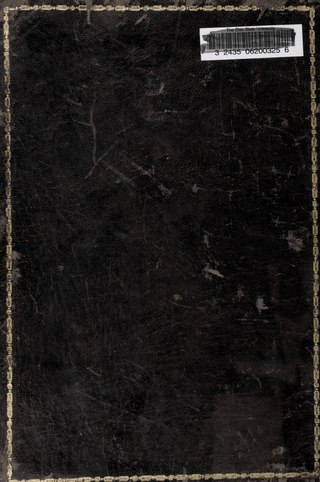
The Ottoman Code of Public Laws, also known as the Düstur or Destur or Doustour, was a set of laws in the Ottoman Empire. The name in Ottoman Turkish comes from a Persian word for a law collection, "Destur". It includes the penal code as well as some civil and commercial laws.
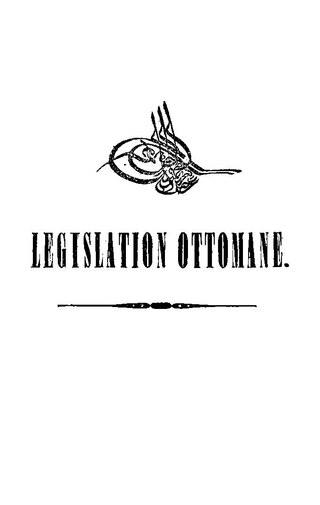
Législation ottomane, ou Recueil des lois, règlements, ordonnances, traités, capitulations et autres documents officiels de l'Empire ottoman is a collection of Ottoman law published by Gregory Aristarchis and edited by Demetrius Nicolaides. The volumes were published from 1873 to 1888.
Demetrius Nicolaides, also known as Nikolaidis Efendi, was an Ottoman Greek journalist and compiler of legislation. Johann Strauss, author of A Constitution for a Multilingual Empire: Translations of the Kanun-ı Esasi and Other Official Texts into Minority Languages, wrote that Nicolaides was "an extremely active but somewhat enigmatic figure in the press life of 19th century Istanbul".
Konstantinoupolis, originally Heptalophos or Eptalofos, was a Greek-language newspaper and periodical published in the Ottoman Empire.
Servet was a newspaper published in the Ottoman Empire. It was initially published by Demetrius Nicolaides, an Ottoman Greek. It was initially only in Ottoman Turkish, though it later also had content in French. It was mailed to people in Constantinople and people in Anatolia, with twice weekly distribution to the latter.
Anatoli (Ανατολή) was a Karamanli Turkish newspaper published by Evangelinos Misalaides, the first in that language made in the Ottoman Empire. It operated 1850–1922, making it the one in that language with the longest length of publication. N. T. Soullides later became the editor.


